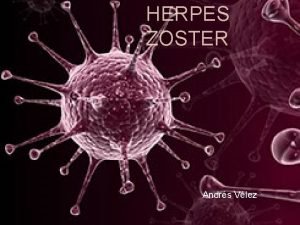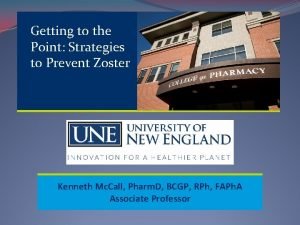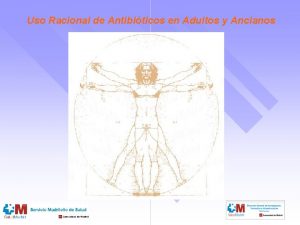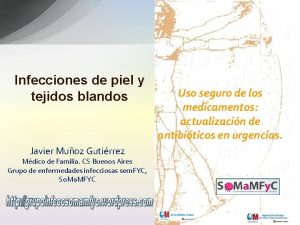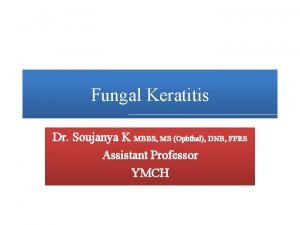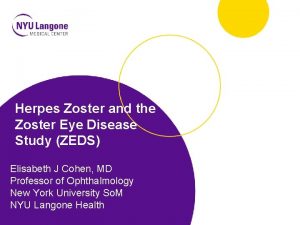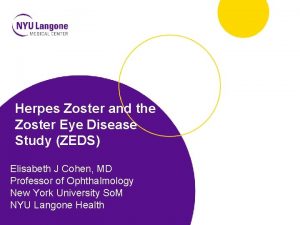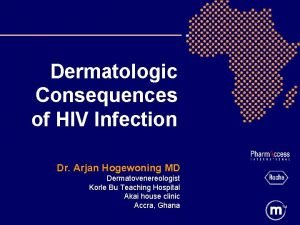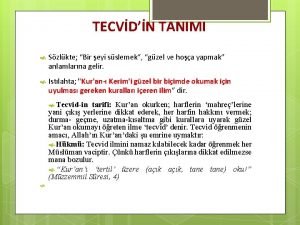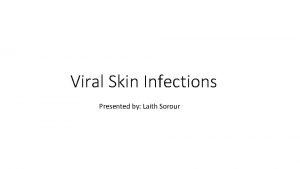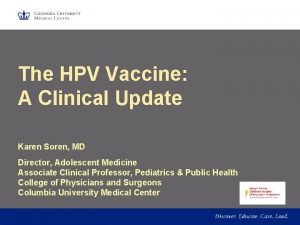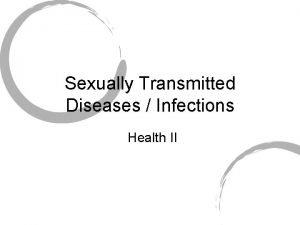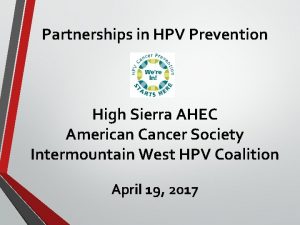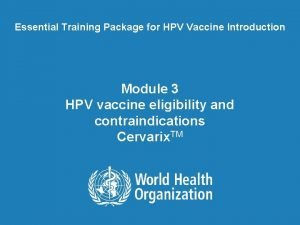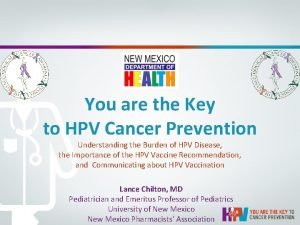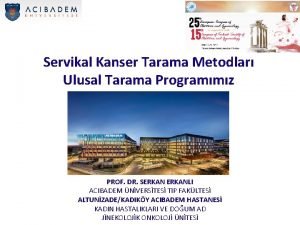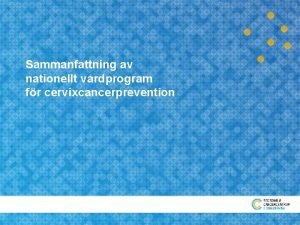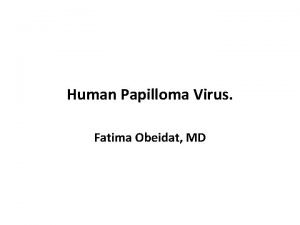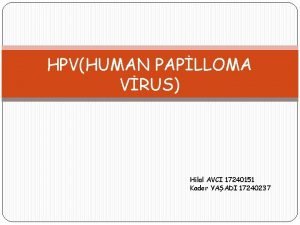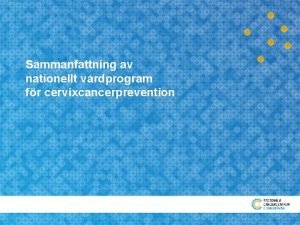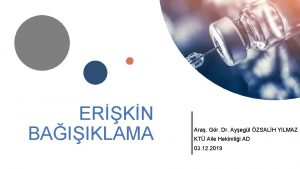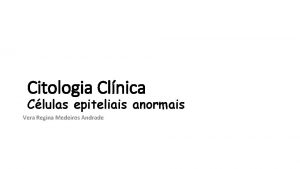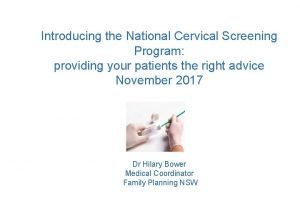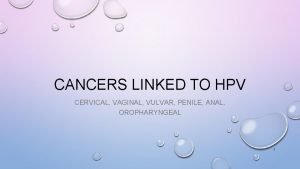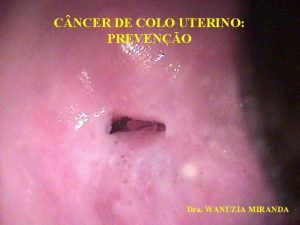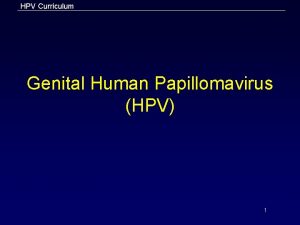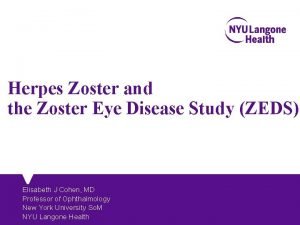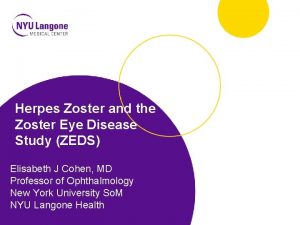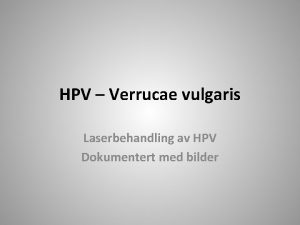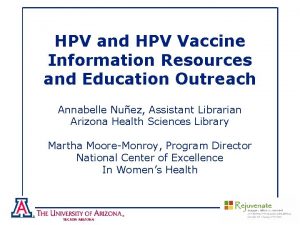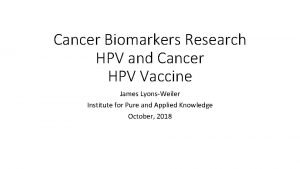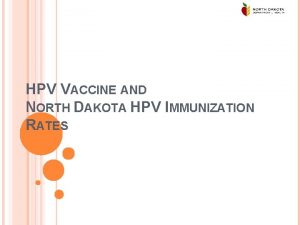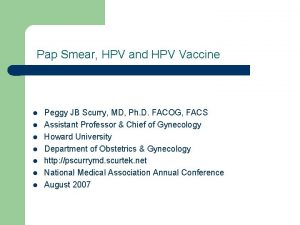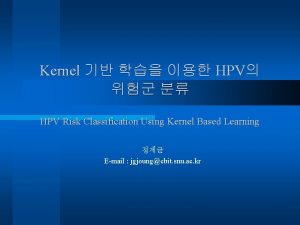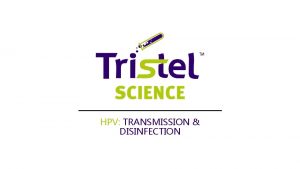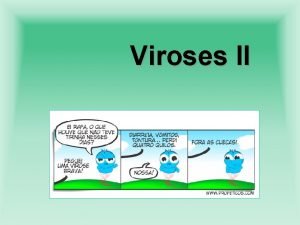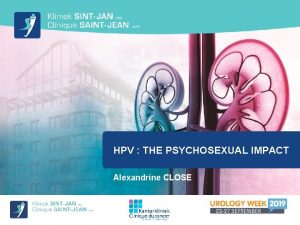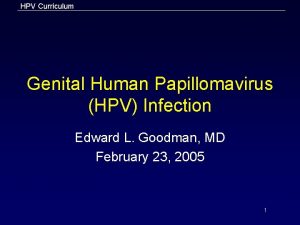HPV and Zoster Etc Med Ch 401 Lecture


























- Slides: 26

HPV and Zoster, Etc. Med. Ch 401 Lecture 9 2 Jun 06 KL Vadheim Lecture 9 1

Human Papillomavirus • • • Papillomaviridae; ds DNA genome ~100 different types Causes warts on various body parts 30 -40 types infect genital tissue Low risk: e. g. , types 6 and 11 – genital warts • High risk: ~ 15 types – 16, 18, 31, 45 cause most cancers 2 Jun 06 KL Vadheim Lecture 9 2

HPV infections • • • Most common STD worldwide ~20 million infected in U. S. ~5. 5 million new infections annually Often asymptomatic Most infections spontaneously resolve Infects cervix, vagina, vulva, anus, penis 2 Jun 06 KL Vadheim Lecture 9 3

High Risk HPVs • Cause intraepithelial neoplasias • Can progress to cancer if undetected/untreated • HPV viral sequences (oncogenes) integrated in cellular DNA • Viral E 6 protein binds/degrades p 53, a tumor suppressor gene 2 Jun 06 KL Vadheim Lecture 9 4

HPV Vaccines Under Review • Merck - Gardasil – Quadravalent (6, 11, 16, 18) – Recombinant – Recommended for approval by VRPAC • GSK – Bivalent (16 and 18) – Phase III trials ongoing 2 Jun 06 KL Vadheim Lecture 9 5

Merck’s Gardasil • Targeted for women 9 -26 years of age • 100% effective in preventing type 16 and 18 infection (~70% cervical CA) • 99% effective in preventing type 6 and 11 infection (90% of genital warts) • Complement to - not replacement for - Pap smears • $300 - $500 per vaccination 2 Jun 06 KL Vadheim Lecture 9 6

Cervical Cancer in U. S. • >9, 000 women diagnosed annually • ~3, 700 deaths • Risk factors for development of cervical CA – high-risk type HPV infection – smoking – having many children – long-term oral contraceptive use – HIV infection 2 Jun 06 KL Vadheim Lecture 9 7

Zostavax • Merck’s shingles vaccine • Licensed May 25, 2006 • Reduce risk of herpes zoster in people >60 – 50% efficacy in all people >60 – 64% efficacy in people 60 -69 • Three-year study 2 Jun 06 KL Vadheim Lecture 9 8

Merck’s Zostavax & Varivax • Oka/Merck strain of live, attenuated VZV • Initially obtained from child with natural varicella infection • Attenuation – Human embryonic lung cells – Embryonic guinea pig cells – Human diploid cells (WI-38) • Lyophilized • Subcutaneous administration 2 Jun 06 KL Vadheim Lecture 9 9

Varicella zoster Vaccines 2 Jun 06 KL Vadheim Lecture 9 10

Tuberculosis • • 2 million deaths annually worldwide 2 billion people are infected worldwide 1 in 10 infected will develop active TB 98% of deaths are in the developing world, affecting primarily young adults • 8. 8 million new TB cases in 2003 – 80% in 22 countries 2 Jun 06 KL Vadheim Lecture 9 11

Pandemic TB • Global incidence is growing at 1% per year • 25% of all cases are in Africa • 50% of new cases are in six Asian countries – Bangladesh – China – India – Indonesia – Pakistan – The Philippines 2 Jun 06 KL Vadheim Lecture 9 12

TB Transmission • Airborne • No animal vector known 2 Jun 06 KL Vadheim Lecture 9 13

Multi-Drug Resistance • Curable, but 5, 000 people die daily • MDR-TB present in nearly all 109 countries surveyed by WHO • 425, 000 new MDR-TB cases every year – highest rates in former URRS and China – up to 14% of all new cases are not responding to standard drug treatment 2 Jun 06 KL Vadheim Lecture 9 14

TB control strategies • U. S. – test and treat – Mantoux test (PPD skin reactivity test) • Europe – BCG vaccination • attenuated TB strain – Efficacy doubtful – Recent studies place efficacy near zero 2 Jun 06 KL Vadheim Lecture 9 15

New TB control strategies • Government commitment to TB control • Diagnosis through bacteriology and an effective lab network • Standardized short-course chemotherapy with full patient support • Uninterrupted supply of quality-assured drugs • documenting patient outcomes 2 Jun 06 KL Vadheim Lecture 9 16

Malaria • • • >1 million deaths annually 300 -500 million acute illnesses each year Endemic in >100 countries >80% of deaths in sub-Saharan Africa Most deaths in infants and young children – 3, 000 children die of malaria every day 2 Jun 06 KL Vadheim Lecture 9 17

Malaria transmission • Single-celled parasite carried by Anopheles mosquito • Many animal hosts in addition to humans • Complex life cycle makes control difficult 2 Jun 06 KL Vadheim Lecture 9 18

Malaria Control • Insecticide-laced mosquito nets – reduces childhood deaths ~20% • Chloroquine – effective against P. vivax, ~30% of cases • Sulphadoxin-Pyrimethamine (SP) – P. falciparum • Drug resistance a problem • Artemisinin-based Combination Therapy (ACT) 2 Jun 06 KL Vadheim Lecture 9 19

Malaria Vaccine Development • PATH – Malaria Vaccine Initiative • GSK’s candidate vaccine ~50% efficacy against most lethal forms of disease 2 Jun 06 KL Vadheim Lecture 9 20

Specific Immune Globulins • • 2 Jun 06 Botulinum antitoxin Botulism IGIV Cytomegalovirus IG IV Hepatitis B IGIV Rabies IG (Human) RSV IGIV (Human) Tetanus IG (Human) KL Vadheim Lecture 9 21

Non-specific IGIV • Immune Globulin (Human) • Immune Globulin IV (Human) • Immune Globulin Subcutaneous (Human) – can be self-administered 2 Jun 06 KL Vadheim Lecture 9 22

Non-specific IGIVs • Highly purified Ig. G preparation • Made from donated human plasma • Used to treat people with insufficient antibody production • Usually given every 3 -4 weeks • Treatment may be life-long 2 Jun 06 KL Vadheim Lecture 9 23

2 Jun 06 KL Vadheim Lecture 9 24

Complaints • Call or write the manufacturer • Provide as much information as possible • Expect an investigation and written response 2 Jun 06 KL Vadheim Lecture 9 25

Recalls and Withdrawals • www. fda. gov/cber/recalls 2 Jun 06 KL Vadheim Lecture 9 26
 Herpes zoster clasificacion
Herpes zoster clasificacion Zostavax reconstitution
Zostavax reconstitution Que es diagnostico diferencial
Que es diagnostico diferencial Tmp smx dosis pediatrica
Tmp smx dosis pediatrica Iridocyctitis
Iridocyctitis Herpes zoster
Herpes zoster Zoster eye disease study
Zoster eye disease study Zoster eye disease study
Zoster eye disease study Herpes zoster infection
Herpes zoster infection Izharın hükmü
Izharın hükmü Hpv type 16 and 18
Hpv type 16 and 18 Hpv type 16 and 18
Hpv type 16 and 18 01:640:244 lecture notes - lecture 15: plat, idah, farad
01:640:244 lecture notes - lecture 15: plat, idah, farad Hpv test for men
Hpv test for men Hpv oral cancer
Hpv oral cancer Hpv vaccine schedule adults
Hpv vaccine schedule adults Hpv cancer prevention
Hpv cancer prevention Hpv testi nasıl yapılır
Hpv testi nasıl yapılır Ascus hpv negativ
Ascus hpv negativ Does hpv go away
Does hpv go away Hpv tipleri
Hpv tipleri Dysplasibarnmorska
Dysplasibarnmorska Bivalan opa
Bivalan opa Lsil
Lsil Cancerscreening.gov.au
Cancerscreening.gov.au Hpv cervical cancer
Hpv cervical cancer Hpv nic
Hpv nic
